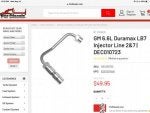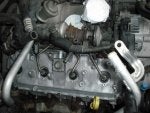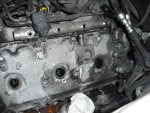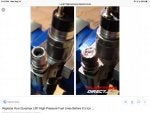I have a 2002 LB7 with about 175K miles and the injectors have about 30K miles (replaced by shop before buying the truck). Over the last couple of years when towing I would get a P1093. Most threads pointed to CP3 getting weak and since there were no other symptoms (truck started and idled fine, no smoke, balance rates at idle were good, etc) I decided that must be the issue. I didn't really start noticing lack of pulling power until last March but still day to day unloaded it ran fine so I just let it go until I had time to tackle the job. Last month at the end of a camping trip my crankcase overflowed with diesel (vibration at idle in stop and go traffic and the whole underside of truck dripping with oil/diesel when we got home). Admittedly I don't check my oil that often since every time I have it has been fine and there are no leaks and I don't drive the truck that much - so for all I know it had been slowly filling for quite some time. On this trip I did notice the oil pressure being lower than usual but not in any danger zone.
I read CP3s can leak fuel into the crank case so I figured since it was on its way out I should change it and see if I continued to get diesel in the crankcase but at lest my P1093 would be taken care of.
So it is all back together and runs fine - actually it runs EXACTLY like it did before - I have about 700lbs worth of large yard rocks in the bed so it is under a load and the P1093 came back when running an errand. No sign of diesel in the oil but I have only put 20 or so miles on it and if it was just seeping in before I think it should take a while to show up to where I could see/smell it - yes? BTW I replace the fuel filter at each oil change - but not this time after draining all the oil/diesel out - so I am pretty doubtful that it is that since I have changed the oil after I first started getting the P1093 code - but I might change just to be safe.
So... cracked injector body? Broken return line? Anything else it could be that I can throw a part at without removing the valve covers? I have a lift pump that I put on when I started getting the P1093 and made no change.
I really really don't like taking my truck to shops - quoted me +$600 to replace the belt driven vacuum pump that I ended up doing my self for about $100 - so ANYTHING I can do in my driveway I am game to try.
Thanks
I read CP3s can leak fuel into the crank case so I figured since it was on its way out I should change it and see if I continued to get diesel in the crankcase but at lest my P1093 would be taken care of.
So it is all back together and runs fine - actually it runs EXACTLY like it did before - I have about 700lbs worth of large yard rocks in the bed so it is under a load and the P1093 came back when running an errand. No sign of diesel in the oil but I have only put 20 or so miles on it and if it was just seeping in before I think it should take a while to show up to where I could see/smell it - yes? BTW I replace the fuel filter at each oil change - but not this time after draining all the oil/diesel out - so I am pretty doubtful that it is that since I have changed the oil after I first started getting the P1093 code - but I might change just to be safe.
So... cracked injector body? Broken return line? Anything else it could be that I can throw a part at without removing the valve covers? I have a lift pump that I put on when I started getting the P1093 and made no change.
I really really don't like taking my truck to shops - quoted me +$600 to replace the belt driven vacuum pump that I ended up doing my self for about $100 - so ANYTHING I can do in my driveway I am game to try.
Thanks









